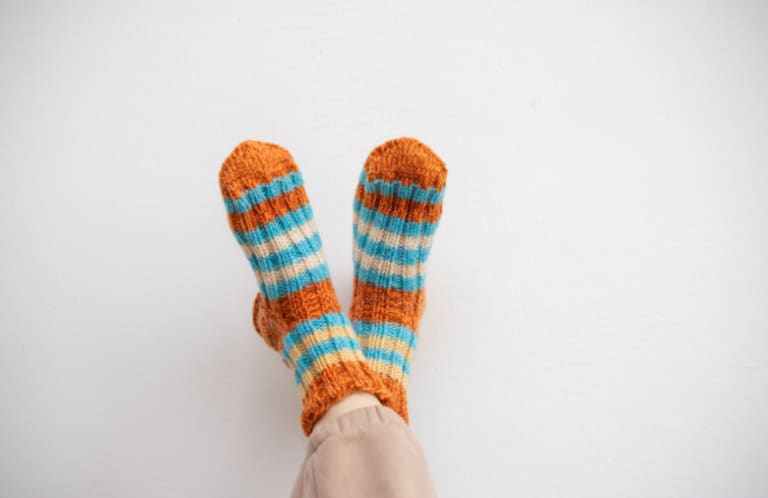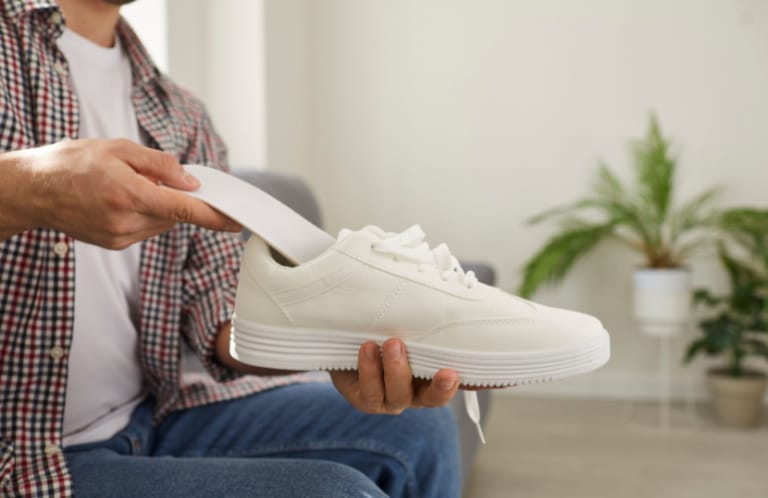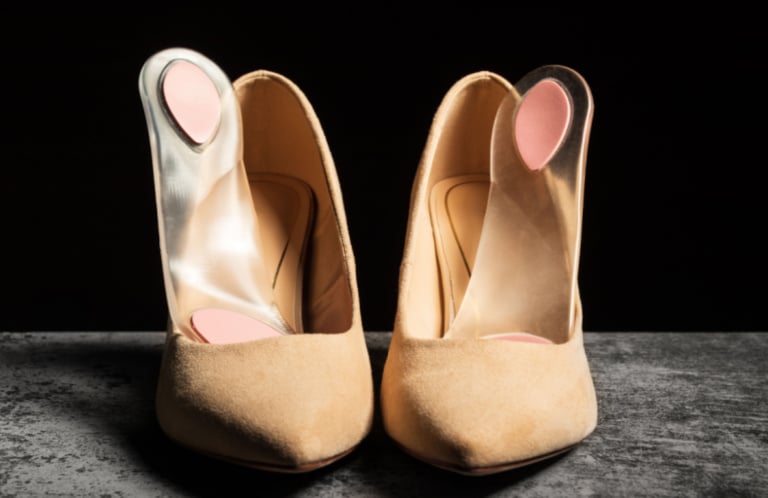
You’ve bought a lightning deal for a pair of shoes online out of a stroke of pure luck. That luck ends when the shoes arrive at your door. You pull them out, and they’re about a half size to a full size too big. If you don’t want to return your shoes and want to find every option to make them work, keep reading.
Contents
Shrink Shoes in the Dryer
If your shoes are made from cotton, you could use the dryer to shrink them down a half size down to a full size.
Cotton naturally shrinks in high heat. If you wet your shoes then throw them in the dryer for about 20 minutes, you can constrict the cotton around your shoes and have them fit better.
Of course, you can’t put all types of shoes in a dryer, such as with finished leather, synthetic material, or suede. Be sure to keep the brand of shoes handy, so you can look up what the shoe is made of. In general, cotton and canvas shoes are okay to put in the wash, but read up on the company’s website to see if your shoes are the exception.
Use Water to Shrink Shoes
Conversely, if you’re worried about the heat from the dryer affecting the non-cotton parts of your shoes, such as the sole or eyelets, you could dab water onto the cotton portion of the shoe and get your hairdryer out.
Put the heat from the hairdryer on low. You don’t want to damage the cotton from too much heat, especially if you accidentally hold the hairdryer too close to the shoes. You also don’t want to ruin the soles of the shoes, which can be made brittle when wet and put close to the heat.
Heat Up the Shoe With an Iron
If you don’t have a blow dryer handy, you could also employ a clothing iron to heat up your shoes without damaging the material.
The first thing you want to do is see which part of the shoe needs shrinking. Often, it’s not the whole shoe that fits poorly. The part that’s too roomy could be the toe area, or maybe your heel slips out.
When wearing your shoes, pay special attention to where you think you could be tapered off through the shrinking process. Doing this will save you lots of time, effort, and headache during the shoe shrinking process.
Never put the iron directly on your shoes, as the extreme heat could damage the glue or rubber. Instead, place a damp rag over the shoe. If you have the type of iron where you can spray water onto what you’re ironing, be sure to keep the cloth damp. Don’t let the heat evaporate the water.
Run the iron over the parts of the shoe you want to be tightened. If the shoe is made from leather, be sure to use broad, even strokes to ensure full heat coverage — you don’t want the iron to stretch some parts without stretching others.
For cotton, make sure to apply lots of heat, but give your shoe a break after about 15 minutes. The cotton could become heat stressed and tear when worn.
After you think you’ve gotten all of the shoes you wanted to cover, turn off the iron, remove the rag, and let the shoe cool. It should take about 5 to 45 minutes to do so, depending on the material you ironed.
When the shoes cool down, test them out. If they’ve shrunk to an appropriate size, you should be good to go. If the shoes are still a bit too big, you could dampen the cloth once more and try again.
If you’re working with leather, though, be sure to condition the shoes afterward. The water and the heat could have dried the leather out, making it more prone to cracks and creases.
How to Make Shoes Fit Smaller
1. Wear Thick Socks
Technically, this isn’t shrinking down the shoe but makes your foot bigger. Your foot occupies the excess space, and the shoe fits snuggly.

Granted, you could mostly do this option if it’s cold outside. If you live in the Midwest or somewhere where it’s cold most of the year, you shouldn’t have a problem with this method. For those living in hotter climates, your feet will not appreciate the extra layer of warmth surrounding them.
If you can manage thick socks without overheating, this method will be the fastest. If you get too hot, though, consider the below process.
2. Stuff the Toes
This next method is excellent to minimize the cavernous toe space that afflicts people wearing large shoes. Your heels fit fine, the midfoot stays put, but you feel like your toes are swimming in too much room.
An immediate fix would be to take toilet paper or a napkin and stuff it in the toe space of your shoe. The toilet paper cushions the area between your foot and the tip of the shoe, creating a more comfortable wearing experience.
If you find that toilet paper shreds throughout the day and makes a mess inside your shoe, you can swap out the toilet paper for a small sock instead. You could also cut out a square of cloth from an old t-shirt or pillowcase — anything durable enough to withstand the constant movement of walking.
Walking with shoes that are too big can be annoying, especially if you can’t pop back home to wear put some extra socks on your feet. For a quick fix, you can do nearly anywhere, find some toilet paper, and stuff it into your shoes.
3. Use the Insole of Another Shoe
Lots of shoes have removable insoles, such as cheap slippers from a clothing store or an old pair of running shoes that fit you well.

Take the insole from a shoe that fits you well and place it inside the shoe that’s too big. The second insole takes up some of the dead space and shrinks the available space for your feet, making the shoe fit better. Besides, the shoes will most likely be more comfortable on your feet because of the added insole softening each step you take.
You can sacrifice the insoles of one pair of shoes to make wearing the larger pair of shoes fit better. Apply adhesive to the bottom of the added insole to stop it from slipping out every time you remove your foot. If you want to keep your shoes pristine, you could opt for some tape to hold the insole in place.
It’s unlikely that anyone will see the second insole of your shoe, so feel free to use whatever style you want to make wearing your large shoes the most comfortable possible. You’ll most likely gain a quarter of a size to half size in the process. And if there’s still too much room, you can use the toilet paper or sock method from the previous example.
You might also like:
- How to Stop Shoes From Rubbing Achilles
- How to Prevent Toe Holes in Shoes
- How to Fix LED Shoes
- How to Get Paint Off Shoes
- How to Get Sharpie Off Shoes
4. Buy an Orthotic
An orthotic is a device designed to align your bones and muscles. They can be a brace that forces a leg to align straight, or it can be a shoe insert to align the position of your foot.
You can get shoe insert orthotics to not only make your large shoe fit better but correct your overall health as well. Each step you take will be straighter and more aligned without the foot is naturally supposed to walk. Most people buy shoes one size up to fit their prescribed orthotics anyway, according to podiatrist Tom Biernacki.
Since you already have shoes that are too big, you can go ahead and save your feet by getting orthotics to slip into the insoles.
5. Get Shoe Pads
Shoe pads don’t cost much and can be applied to your shoe within seconds. They’re cushions with adhesive on one side. You stick them underneath the tongue of your shoe, and they help remove space between the middle of your foot and the sole.
If your foot flips around too much or feels too roomy, applying shoe pads could fix the issue. They’re cost-efficient — usually costing a few bucks for a large pack. If it doesn’t rain, the adhesive could last weeks, even months. There’s nothing better to remove excess room in the midsole than to stick on a shoe pad, so go ahead and get some.
6. Apply Heel Pads
Heel pads are also inexpensive inserts you can put on the inside of your footwear to reduce the amount of space inside them. Heel pads have one soft, padded side and another adhesive side that sticks to the interior of your heel.

Applying them will not only make wearing your shoes more comfortable but make them fit a bit snugger as well. You could double up on heel pads to further reduce the space. You’ll not only avoid heel slipping and wearing your shoes like a flip-flop, but your shoes will also feel like tiny clouds on your feet.
7. See a Shoe Cobbler
A cobbler is essentially a shoe guru. In more practical terms, they’re a person who restores or repairs shoes. They know the ins and outs of soles, heels, toes, and the space between all of them to make shoes fit their clients in the best way possible.
If you really like your shoes and want a long-term solution to make them fit better, find a cobbler in your area who can tailor your shoes to your foot. It might cost you some money in the short-term, but imagine how much more you’ll enjoy your shoes when they fit you better.
8. Become a Shoe Cobbler
If for some reason, shoes never seem to fit you, you can learn how to become a shoe cobbler. There are many classes on how to repair and alter shoes, and there are lots of examples on the internet in which experts share their knowledge for free.
If you have a shoe size or foot shape that means you’ll never find the perfect pair of shoes in the store, you might find your quality of life much better if you learn how to alter footwear to your tastes. Learning to become your own personal shoe cobbler means using your book-learning for practical use.
Check-in with your local cobblers to see if they’ll take on trainees. You could work beside them as they alter shoes and pick up a trick or two from your time there.
If working for a cobbler doesn’t seem like an option, you could go to Shoe Repair School. There are some in Arizona, but there could be a few schools closer to your area. You could practice your shoe altering chops on the current pair of shoes you have, that are too big.
9. Return the Shoe
If worse comes to worst, it would be best to return the shoe. Sometimes shoes are made with such finicky material that, no matter how much time, heat, and effort you put in, the shoe will stay the same size. Or perhaps even if you shrunk the shoe down enough to fit the top of your foot, the sole is still too long. There’s less you can do to shrink down a shoe sole.
Know when it’s time to call it a day and throw in the towel (perhaps the one you used to iron your shoes). Shrinking is a way to get shoes down a quarter to half size down. You could decrease your shoes a full size down, but it’s not likely to last long.
If you bought your footwear from an online store, talk to the company to see if they’ll let you return your shoe. Most online companies have excellent return policies because they know their customers often don’t know how exactly a garment fits until they have it in their hands.
Buying your shoes in person at a store could cause a few more issues — especially if you had the opportunity to try on the shoes before you purchased them. Still, stores tend to let customers return their shoes if they keep the receipt and return their shoes in a timely manner. Contact the brick-and-mortar store to see if you’re still eligible to give back the shoes.
Finally, if you sought to shrink shoes because they were a one-of-a-kind buy, you’ll have to grit your teeth and accept your losses. Thrift stores have fabulous finds, and we can often convince ourselves that we can shrink shoes down to make them fit if we put in enough time and effort. Sometimes these efforts succeed. Other times, they don’t.
Learning when to stop trying to shrink the shoe and return them to the store does two things: if you bought the shoe from a chain store, you give the item back to a company that can then resell it, making both you and the company happy. If you bought the shoe from a thrift store, returning the item could make someone with bigger feet than you incredibly happy.
Don’t get bogged down with, “But it was a great deal!” and “I’ll never find shoes like these again!” If it’s not meant to be, it’s not meant to. Return the shoes and clear up closet space for a pair that fit you better.
Latest Post:
- Where Are Vans Made? (Ultimate Guide Revealed)
- How Much Do Shoes Weigh?
- Lights On, Troubles Gone: How to Fix LED Shoes Like A Pro
- Do Vans Run Big or Small? (All You Need To Know)
- Do Adidas Run Big, Small or True to Size?
10. A Note About Returning Shoes
Some companies may reject your attempt to return the footwear if it’s obvious you tried to shrink them. The company sold you the shoes in one size and in one condition, so if you return the shoes as a different size or with burn marks on them, that company is a lot less likely to accept the shoes.
If you attempt to stretch your shoes, know the risks if you find your efforts lead to no lasting results. You could forgo any chance of getting your money back — if that was an option in the first place.
So, before beginning the shoe shrinking journey, know that you can cut your losses and return the shoes. If you can’t get your money back, then shrinking the shoes might be the only way to salvage that purchase. If anything, you could donate your shoes to a thrift store if they’re still in wearable condition. Someone will be happy to have your shoes, even if shrunk.
Shoe stretching isn’t easy, and there’s no guarantee that you can successfully shrink your shoes. You can use artificial methods to decrease the amount of spare room in your footwear, such as stuffing the toe of your shoes with socks, buying heel pads, or getting a separate insole to stick in the shoe. When in winter, wear a double layer of socks for a quick, easy fix.
Trying to shrink the whole shoe, though, is a bit dicier. Keep trying these methods until you cut down the shoe size a half size. If you’re lucky, you could get it down a full size. Who knows, your particular shoes could be the magic pair to shrink quickly. Just follow the advice in this article thoroughly, and you might get the results you’re looking for.
